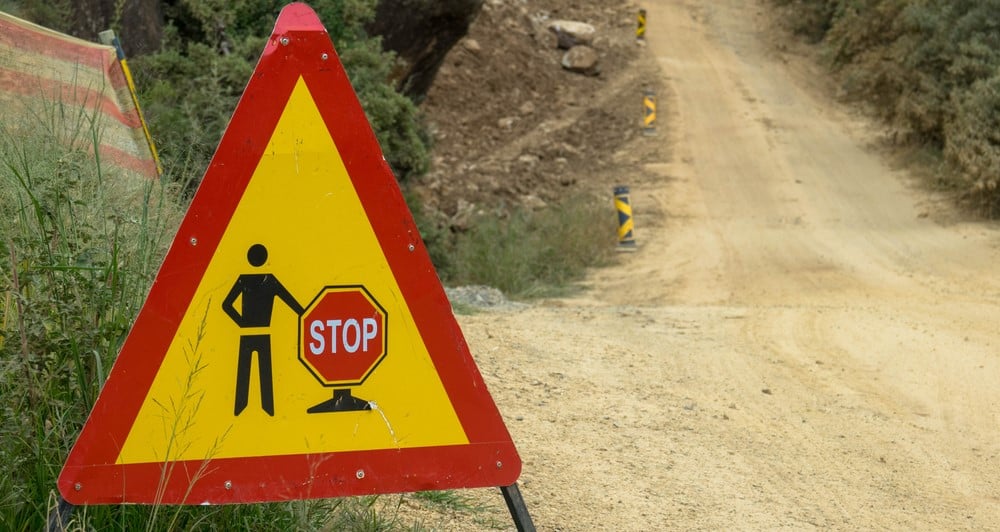
Bypass roads can cause a real headache in terms of airborne dust. Yet they are necessary to ensure traffic can continue to flow during any type of construction work, whether it’s on a mine site or affects a public road.
Temporary bypass roads are usually made from granular fill or aggregate placed over existing ground or sub soils. The granular fill or aggregate acts as the road surface itself. Usually the surface will be left untreated and therefore be prone to generating plumes of wheel generated dust. So an effective dust control solution needs to be found to avoid visibility and other safety issues.
If significant construction work is being done, bypass roads can be in use for 3 - 6 months. The most common tactic used for preventing dust from becoming airborne during this time by traffic is to spray the road surface with water using a water bowser. This is usually done on a daily basis to saturate the dust particles and keep them on the ground.
However if this approach is continued for the duration of the whole project, the fine materials (75 microns and less) of the roads’ surface will eventually start to wash away. This will create potholes and expose sharp stones which poses obvious hazards to tyres.
To prevent dust from becoming airborne and to keep drivers safe, an appropriate strategy incorporating the use of dust control binders needs to be implemented.
Spray On Dust Control Binders
There are many different types of dust control binders available on the market, each with specific benefits and formulated for different road types or volumes of traffic. Three of the most commonly used formulations are bitumen emulsions, lignosulfonates and surfactants.
When a dust control binder is sprayed onto a temporary road surface, fine materials interlock and hold everything together, quickly mixing with the applied binder. This makes it easier for the binder to mix with the wearing course layer of the road. Dust particles are then effectively prevented from becoming airborne and the road surface is strengthened. Many dust control binders (such as Dust-A-Side’s AquaTarp) also have a waterproofing effect, making bypass roads safer for drivers in wet weather.
Provided that a dust control binder is applied to a temporary road early on during its establishment and before any fine materials are washed away, light re-sprayings of the binder are only required every 2-3 weeks - depending on traffic levels. This represents a huge cost saving to the operation as there is no need for a water bowser operator to be on site every single day.
If a dust abatement binder is used after water carts have already been used and much of the fine material is gone, more fine materials will need to be brought in and laid on the road surface in order for the binder to work. So it’s best to get it right from the start.
Environmental Issues
The great thing about dust control binders is that they are environmentally friendly to use. Contractors do not need to worry about the leaching of any chemicals into the surrounding environment and the risk of fouling waterways. Most dust control binders are made from natural materials as detailed below.
- Bitumen Emulsions: Due to the fact that bitumen is an oil based product, some people hold concern about using it on roads. However, since bitumen emulsions are largely water based, and often highly diluted, they have minimal impact on the environment. Also, the emulsion works to form a water-impermeable layer on the road surface, so there is no risk to surrounding vegetation or the underlying soil once it cures. See our bitumen emulsion binder DAS Product.
- Lignosulfonates: Lignosulfonates are by-products from sulphite paper and timber making processes in which sulfonated lignin, a polymer built up of phenyl propane subunits, is dispersed in an aqueous solution. These binding properties of lignin are enhanced by the addition of sugars which helps bind surface road particles together. Lignosulfonate based products have very low toxicity towards plants, low order of toxicity towards fish and present no risk of contaminating groundwater. See our lignosulfonate based binder HydroTac.
- Surfactants: Surfactants work by enhancing the attraction of treated water molecules to the dust particles and increasing the water droplets’ performance. Dust particles are therefore less susceptible to becoming and remaining airborne. Many surfactants available today are environmentally friendly and some are even biodegradable. Formulations are based on organic surfactants rather than synthetic polymers. They are often solvent-free, non-corrosive and water based. Studies have shown surfactants to be non-toxic to humans, animals, marine life and plants. See our surfactant based binder HydroWet.
Conclusion
As we have explored above, dust binders provide an effective and cost-saving alternative to just spraying water for dust control on temporary roads. These binders are environmentally friendly and shown to reduce hazards on bypass roads by improving visibility and preventing the washing away of fine materials.
Dust-A-Side South Africa has a range of dust control binder products available, each with different benefits and each suitable for different applications.
Our experts will be able to recommend which product is right for your specific road management and dust control needs. Give us a call on +27 12 648 8900 or click here to send an enquiry.
![DAS_South Africa-Logo_Y[P]_SA DAS_South Africa-Logo_Y[P]_SA](https://news.dustaside.com/hs-fs/hubfs/DAS-South%20Africa/SA%20Logo/DAS_South%20Africa-Logo_Y%5BP%5D_SA.png?width=670&height=175&name=DAS_South%20Africa-Logo_Y%5BP%5D_SA.png)

